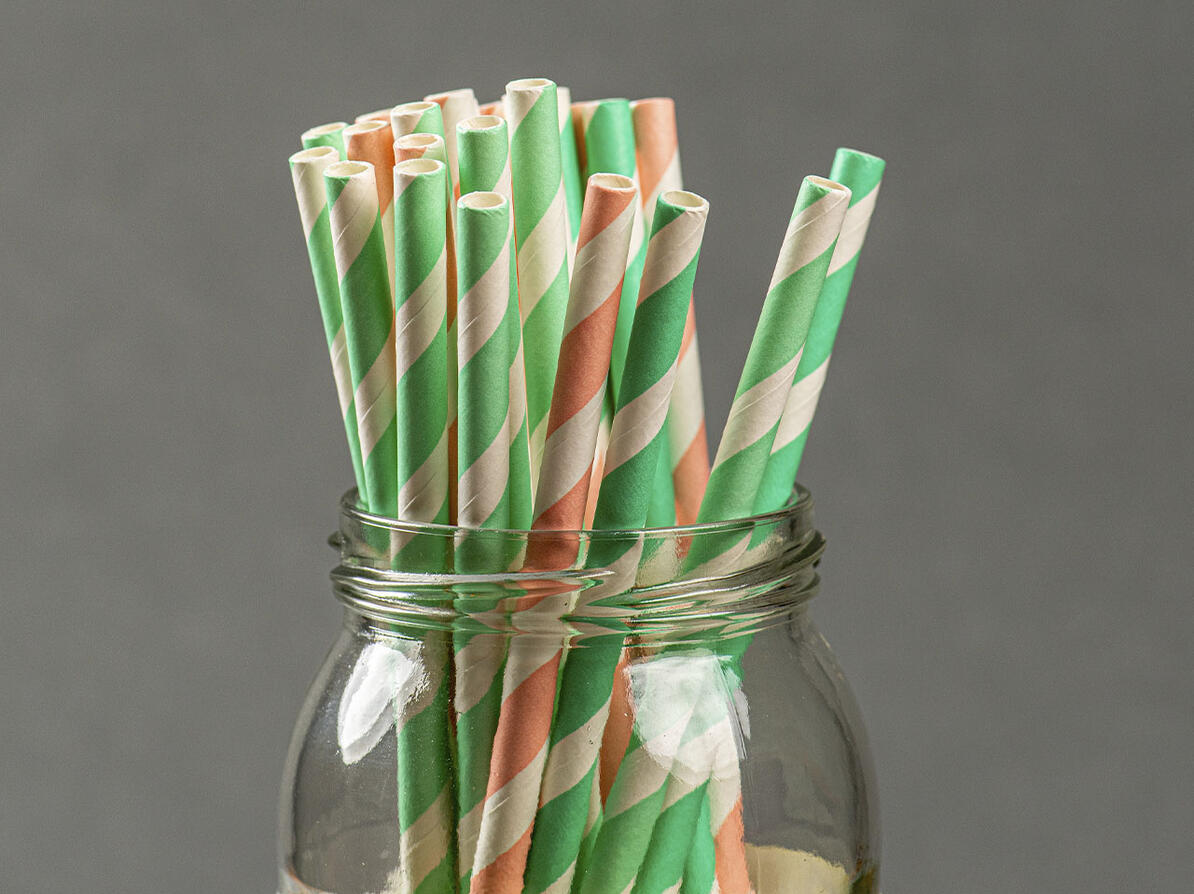Test: Unwanted chemicals in colorful foodpackaging
Coffee cups, paper straws and pick-and-choose candy bags may contain suspected carcinogens. The problematic substances come from the colorful print on the packaging and can migrate to the food.

Paper straws, coffee cups and candy bags contain unwanted chemicals
Unwanted substances can be released from colorful prints on disposable packaging - for example paper straws, paper bags for pick-and-choose candy and coffee cups.
20 different disposable food packaging products from the Danish market have been tested for selected problematic substances. All tested products were of cardboard or paper and with colorful printing.
In 4 cases the test showed that the products contained substances suspected to be carcinogenic.
The problematic substances are called primary aromatic amines. They typically originate from the printing inks on the packaging.
Primary aromatic amines are a large group of substances, many of which are carcinogenic. Others are suspected of being so due to the similarity between the substances.
The substances can migrate from the packaging into food and drinks. For some products like paper straws there will also be direct mouth contact to the product while drinking.
Danish results are similar to the European
The test is part of a European test in which a total of 76 different kinds of packaging have been tested.
Different products have been selected for analysis. Both disposable packaging like the one bought on the Danish market as well as packaging for grocery products such as raisins and pasta.
The result of the Danish test reflects the overall test results from the full European test.
In total, 17 percent of the tested products either had high content of potential carcinogens or high migration of other substances related to the printing.
For disposable packaging eco-label is a good choice
The test shows that in many cases colorful food packaging can be free of primary aromatic amines. All the product types can therefore be made without the unwanted substances.
The nordic eco-label is a good choice if you want to buy disposable food packaging materials yourself. The label set up environmental and health requirements for both the packaging as well as the ink.
About the test
-
Many different chemicals are used and can be present in food packaging materials. Some of them are already known to be problematic for our health - for others knowledge is lacking.
The current legislation for most food packaging materials only requires that the packaging does not release chemicals in quantities that pose a risk to health. It is far from enough to provide sufficient protection of consumer against problematic substances in food packaging material.
The Danish Consumer Council believes that comprehensive and preferably EU harmonized chemical requirements based on a precautionary principle must be implemented for all types of food packaging including cardboard and paper as well as the inks used for coloring.
-
How we tested:
The Danish Consumer Council Think Chemicals has in collaboration with 3 other consumer organizations in Europe (Altroconsumo in Italy, OCU in Spain and Forbrukerrådet in Norway) conducted a test with the purpose of investigating whether a wide range of cardboard and paper packaging with colorful printing contains unwanted substances.
All the tested packaging is intended to come into contact with food or drinks.
In total, 76 different packages have been tested.
Products that have been purchased and tested are:
• coffee cups
• soda cups
• paper plates
• baking bags
• candy bags from pick-and-choose candy stores
• napkins
• paper straws
• muffinforms as well as
• various grocery products such as pastas, noodles, raisins etc.20 of the products were purchased in Denmark. All of them were disposable packaging.
The packaging were tested for:
• Primary aromatic amines (PAA) derived from printing inks, previously found in colored napkins.
• UV filters - or so-called photoinitiators - including various benzophenones as well as ITX, previously found in various food packagings and fooditems, as well as other substances that can origin from the printing ink.How we conduct tests in The Danish Consumer Council THINK Chemicals
What we found:
The result for Danish products:
• 15 products were without primary aromatic amines (PAA) and contained no or only small traces of the tested photoinitiators and other substances related to the printing ink.• 4 products had extractable PAAs at higher levels, and
• 2 products released UV-filters or similar substances related to printing inks in higher levels.Results - primary aromatic amines:
In 4 of the 20 Danish products (20 percent), the test showed content of extractable PAAs at levels above the recommendations for paper and board food contact materials of BfR (The German Federal Institute for Risk Assessment) or the EU legal requirements for PAA in plastic food packaging material.
Products from Denmark with PAAs were:
• Joe & The Juice Coffee Cup
• Aristo Candy bag
• Sugar Top Sweet Bag
• GoDan Paper Suction TubeThe result of the overall European test showed that there were extractable PAAs in levels above the detection limit in 13 out of 76 (17 percent) of the tested products.
In 9 of them (12 percent) the concentration was above the recommended level.
PAAs were found in virtually all of the product types tested. However, for all the product types there were also products without.
What are primary aromatic amines?
Primary aromatic amines (PAA) are a group of chemical substances that are used in the production of certain dyes - the so-called azo dyes.
Residues of PAAs can be present in the finished dyes, and when used for the printing on the food packaging, the PAAs can also be found in the packaging.
When the packaging is in contact with the food, the substances can migrate into the food and consumers can thus be exposed to the unwanted substances. In some cases, there can also be direct contact with the packaging - for example, when drinking from a straw or from a coffee cup.
PAAs have previously been found in products in contact with food, such as colored napkins and baking bags.
Several of the PAAs are or are suspected to be carcinogenic as well as genotoxic. Several of the substances are classified in the EU as carcinogens or possible carcinogens.
In plastic food contact materials, the sum of all PAAs must not exceed 10 micrograms per kilogram.
The German Risk Assessment Institute, BfR, recommends a similar limit also for cardboard and paper packaging. At the same time, the most carcinogenic of the PAAs should not be found in even smaller amounts. According to BfR, the exposure to these carcinogens should be minimized.
The highest concentration of PAAs in the test was 6.5 times above the limits for plastic food contact materials.
Read BfRs recommendation (eksternal link)
In May 2019 the EU Commission has recommended that member states investigate the content of, among other things, PAAs in cardboard and paper packaging for food.
The current test shows that there is a problem with these unwanted substances in cardboard and paper packaging.
EU-Commision reommendation (eksternal link)
Products with unwanted UV-filters or photoinitiators:
A relatively high content of different UV-filters and other substances that may originate from the printing ink was found in 21 of the 76 tested products in total.
The concentration of the substances in the 21 products were at a level where it potentially could give rise to a release at levels above the Swiss requirements for substances used in printing inks on food packaging also known as the Swiss ordinance, Annex 10.
Swiss ordinance: Materials and articles in contact with food
Amongst the 21 samples were primarily packaging for grocery products such as raisins, crispbread and pasta.
In 8 of the 21 products it was UV-filters, while the remaining 13 products had a high content of another substance, Bis (2-ethylhexyl) fumarate, which, like the UV-filters, can originate from the printing inks, but also may have other origins.
The release of substances from these 21 packaging’s was examined and in 8 of the 76 products tested (10 percent) the substances were also found to migrate to the food.
In 6 of the 8 products, the migration was above the limits set out in the Swiss ordinance.
Two of these products were from the Danish market. In both cases, they were paper straws.
In total, we found the release of 8 different substances - 7 UV filters as well as one other substance that can also be connected to the printing inks. It is mainly substances with only limited knowledge in terms of health, which in itself points to a problem.
For several of the substances, it has not been possible for the Swiss authorities to set a limit based on a scientific risk assessment of the substance. They have therefore set a generic limit based on a precautionary principle that substances that cannot be evaluated for safety due to missing data should not migrate from packaging to food.
What are UV filters or Photoinitiators?
UV-filters that absorb UV-rays are used in packaging to protect both the packaging and the food from the degrading UV-radiation. In addition, they can also be used in printing inks, where they can, among other things, act as so-called photoinitiators, which help to start a chemical reaction that among other things can cause the printing to dry faster.
The substances are very different, some are relatively well-known, such as benzophenone, which is suspected of being endocrine disrupting or ITX, which is allergenic, but there are also many of the substances with only limited knowledge and therefore not assessed in relation to their safe use in food packaging.
-
Joe & The Juice
Joe & The Juice write in an email to the magazine of the Danish Consumer Council that they would like to find the right solution, not just the fastest solution, that is both sustainable and safe in the future. They have not told what they will do with the specific cup.
Aristo
Aristo states in an email to the magazine of the Danish Consumer Council that it is a trend in their company as well as in the market, in general to produce products with either less or completely without print. The company has not told what they intend to do with the specific bag.
Fest4All - dealer of straw from Godan
Fest4all has informed the Danish Consumer Council THINK Chemicals that the tested straws have been discontinued at Godan, and also that they no longer have any of them in stock.
